Redesigned from the ground up, the new Specialized Riprock 20 and Specialized Riprock 24 are a little ripper of a bike ready to put young groms in action. This upgraded Riprock is a brand new trail beast – it lost a few pounds from its predecessor, has taken on a slacker, more modern geometry, boasts hydraulic disc brakes, and comes internally routed for a dropper post!
Available in 20 and 24 inch wheel sizes, the base level Riprock comes with a rigid fork (gasp! – actually no, it’s a good thing), while the Riprock Expert is available with a suspension fork, but only on the 24 inch model.
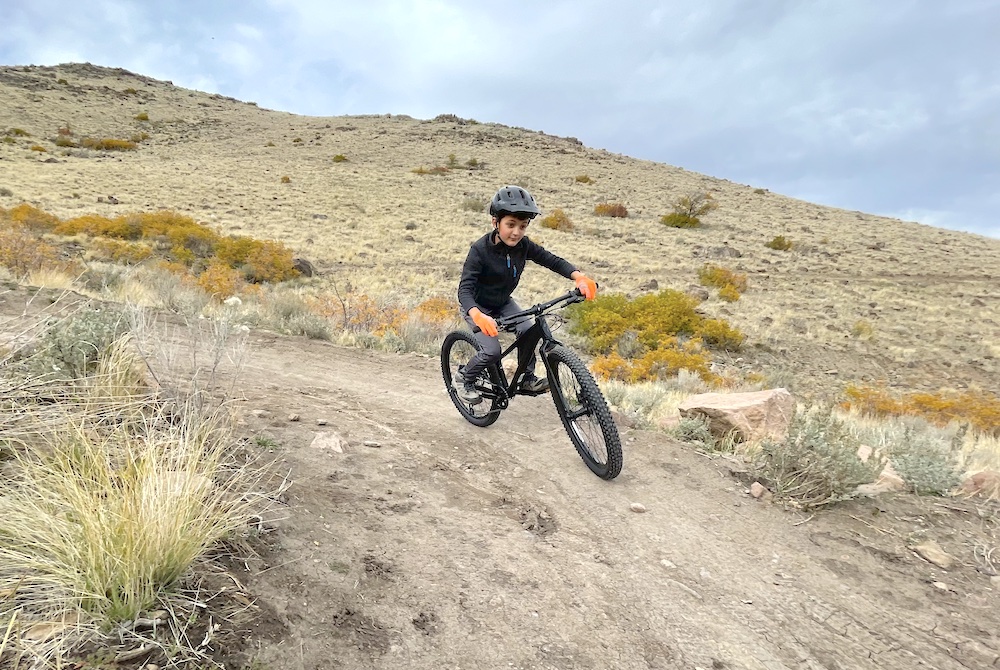
While we haven’t had Specialized’s new pony for long, it didn’t take long for our 9-year-old tester to declare his love for the Riprock! But how does it compare to other kids mountain bikes on the market?
We will continue to update this review with more details the 20″ and 24″ Riprocks as we have more time to test them. For now, we’ll dive into the geometry of the Riprock and see how these bikes compare to established, higher-end niche brands. Having tested out these other brands as well, we’ll also break down who we believe the Riprock is best for and who would be better served with another bike.
Specialized Riprock Overview

RATING: 24″ – Highly Recommended, 20″ – Recommended with Reservations due to limited fit range
MSRP:$650, $700, $1,500
BEST FOR: Beginning mountain bikers likely to quickly progress to intermediate and advanced green and blue trails
SEAT HEIGHT & WEIGHT:
- 20-inch Riprock: 25″ – 30″, 22.6 lb.
- 24-inch Riprock: 27″ – 32.5″, 24.7 lb.
- 24-inch Riprock Expert: 27″ – 32.5″, 26.4 lb.
GEARS: 9-speed – Microshift Trigger on Riprock; 11 speed – SRAM NX on Riprock Expert
BRAKES: Hydraulic Disc all on models
SUSPENSION FORK: Only on Riprock Expert, Manitou JUNIT 24, 100mm travel
PROS:
- Excellent price point for weight and specs
- Available in stores as well as direct online
- Modern, kid-friendly geometry – not too upright, not too aggressive (68° head tube angle)
- Hydraulic disc brakes with adjustable reach, child-size levers
- Trigger shifters for rapid shifting
- Dropper post compatible
- Front tire fender included to cut down on dust and debris
- Promax hydraulic disc-brakes
- Grippy Ground Control 2.35″ wide tires (tubeless compatible only on Expert)
CONS:
- Long seat posts limit the minimum seat height on the bike – cutting them down can lower the seat 3″ on the 20-inch and 1″ on the 24-inch
- Narrow “great fit” window
- Stock pedals are pretty cheap and don’t spin very well
New Specialized Riprock vs. Old Riprock
The updated Riprock is a complete redesign of the older Riprock models released in 2016. While the 20″ seems to have changed more than the 24″ (see comparison images below), both bikes got slacker and lower, giving the Riprock a true aggressive stance.
Brakes are upgraded from mechanical disc brakes to hydraulic, while the drivetrain jumped up to 9 gears with trigger shifters versus 7 with a grip shift.
To help lower the weight, the tires were actually narrowed from 2.8″ to 2.35″, but the switch is met with a beefier tire to maintain traction.
To help lighten the load, the old Riprock’s heavy, basic suspension fork was done away with on the base model. Meanwhile, the new 24″ Riprock Expert goes all-in on the suspension fork with a pricey, but high-performing, fine-tuned Manitou air fork.

Specialized Riprock 20 and 24 – Initial Thoughts and Comparisons
While I certainly wish my 9-year-old rider loved heading out for a ride every chance we get, that is certainly not the case – even with years of singletrack experience under his belt. But when it’s fall here in Utah, the precious windows of hero dirt are hard to come by, and this mom pulls out every rah, rah cheerleader move possible to get this little man on the mountain. Turns out, it’s going to be a whole lot easier to get him out for fall rides now, as he pretty immediately fell in love with the Riprock.
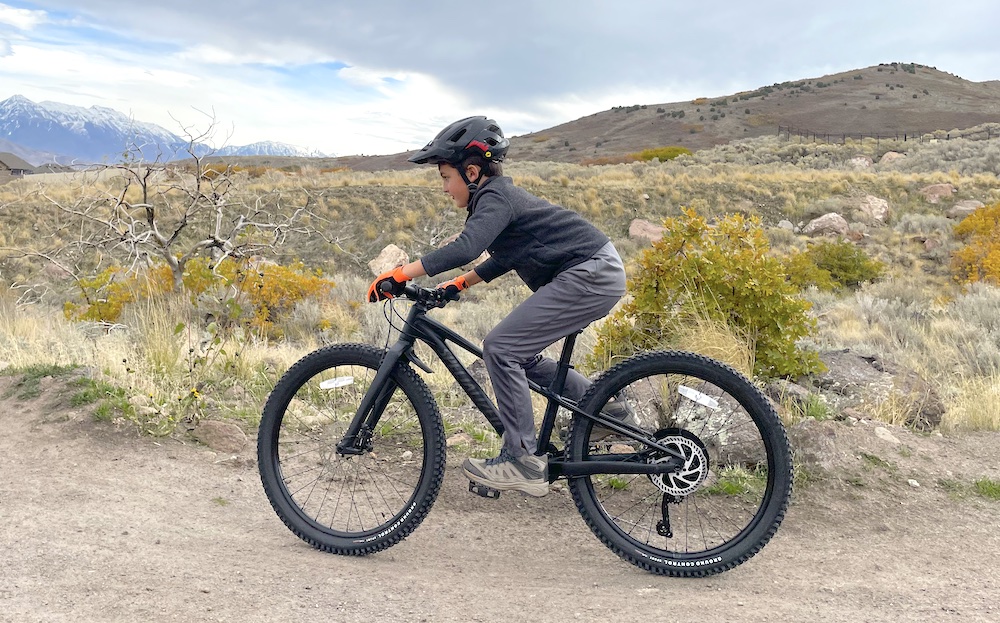
“Wow, this bike is smooth!” From a kid who eats bunny hops for breakfast (well when he is in a good biking mood!), I was shocked to hear him sing the praises of the rigid Riprock completely unprompted.
“This bike just rolls right over big rocks like it’s nothing.” From braking, to climbing, to tackling rock gardens, within the first mile of riding, the Riprock 24 successfully reminded him just how fun mountain biking is.
Whether he was pointed up or headed down, our rider had a grin on his face and we both quickly realized that Specialized has really upped their game in the kids bike world.
Just like their newly released neighborhood Jett kids line, Specialized did their homework and created a true kids mountain bike, versus a small adult bike. While there certainly are a few tweaks that still need to be worked out, based on our testing so far, if your ambitious young ripper is eager to hit real single-track, the Riprock is an amazing bike with plenty to offer – all wrapped up in an extremely reasonable price tag.
What type of rider is the Specialized Riprock best for?
Based on our tests and the Riprock’s geometry, we believe the Riprock is best for intermediate or aggressive young riders ambitious to hit the trails. Developing riders who have the drive and desire to start really ripping will also feel right at home on the Riprock.
The aggressive geometry of the Riprock, however, is likely a bit too much for hesitant riders who aren’t quite convinced about the single-track life. With wider and lower set handlebars compared to other brands (especially the 20″ – more details in the geometry section below), the Riprock 20 and 24 are likely a bit too much, too fast for more timid riders.
For young riders ready to hit drops and chunky rock gardens on a 24″, the Riprock Expert is the ultimate rig featuring a beefier drivetrain, upgraded brakes, and a legit Manitou suspension fork.
A Rigid Fork on a Mountain Bike!?!?
If a bike doesn’t have a suspension fork, then it’s not a mountain bike! We’ve heard this time and time again, but Specialized’s move to a rigid fork on the Riprock is yet another proof point (among the many that have existed for years), that for most kids, the added weight of a suspension fork does more harm than good.
While the additional pounds that a suspension fork adds to a bike’s total weight is a no-brainer for adults, for a 65-pound kid, the weight gain is pretty significant. Those few pounds can equate to a 1 to 5% increase in the bike’s weight compared to the child’s total weight. Can you imagine adding 5% of your weight to your bike?

In addition to weight, most suspension forks designed for kids’ wheel sizes aren’t properly built or tuned to handle smaller forces applied by a lighter-weight child. While they certainly help when powering up curbs or landing jumps, they simply don’t have the finesse to offer the same delicate rebound found on adult forks.
Luckily in the past few years, forks custom-tuned for lighter-weight kids have begun to hit the market on some pretty exceptional kids mountain bikes. Unfortunately, they are pricey (which is the main reason why the Riprock Expert is over double the price as the base Riprock). So in the end, for most young riders who on are on smaller budget, it’s better to save on weight and stick with a rigid bike. But if your young grom is ready to seriously adventure, be prepared to spend a pretty penny.
Sizing of Riprock 20 and 24
According to Specialized, the Riprock 20 is designed to fit kids 42″ to 47″ tall, while both 24ers fit kids 47″ to 55″. Based on our seat height measurements, however, unless you are planning on cutting off the seat post, the lower end of the height recommendations are a bit of a stretch.
We measured the seat height range of the Riprock 20 to be 25″ to 30″. Our 4-year-old 43″ tall tester (an inch taller than the lowest recommended height), however, only has an inseam of 19″ with shoes on, so there is no way she is going to fit on the bike with a 25″ minimum seat height.
The extra-long seat post on the 20″ Riprock doesn’t allow the post to be slammed down all the way and leaves a pretty sizable amount of seat post still showing.
By swapping the seat post of the Riprock with the seat post from another bike, we were able to bring the minimum seat height of the Riprock 20″ down 3″ inches to 22″, which is still a slight stretch for our 43″ tall rider.

The same was true with the Riprock 24. The measured seat height with the standard post was 27″ to 32.5″, but with a shorter post, we were able to lower the minimum seat height to 26″.
That being said, lowering the seat all the way to the seat collar of both bikes positions the saddle really close to the pedal on the upswing, which will make pedaling much less efficient on the downstroke.
Considering the handlebars on the Riprock are also set considerably lower than other bikes (more about this in the geometry section below), the Riprock also isn’t ideal for riders on the taller end of the height recommendations. As a result, we would recommend a narrower height range than suggested by Specialized.
Based on our testers’ experiences, we would roughly estimate the 20″ Riprock to fit heights 45″ to 47″ and the 24″ to fit heights 50″ – 55″. For those riders in between sizes (47″ to 50″) we highly recommend testing out the Riprocks at your local bike shops to ensure a good fit.
Riprock 20 and 24 Geometry
Considering the vast variety of variables that play into a bike’s geometry, it can be pretty tough to hammer out the specifics. Plus, when you throw in the fact that kids grow (and often grow fast!), the effect of the geometry of the bike can change as a child’s proportions change.
Even so, when comparing the new Riprock to the woom OFF and Prevelo Zulu (bikes we are very familiar with), it quickly became clear that the Riprock is certainly on the more aggressive end. With a 68° head tube angle, the Riprock isn’t overly slack compared to other bikes, but its stack is significantly lower than other bikes.
When placed at their minimum seat heights, the saddles of the 20 and the 24 inch Riprock are positioned almost in line with the handlebars. As a comparison, when at their minimum seat heights, the woom OFF and the Prevelo Zulu (both of which allow the seat post to be slammed down to the collar) are inches below the handlebars.
The difference really becomes apparent when testers are placed on the bike. You can see the difference here with our 7-year-old 49″ tall tester. To be fair, she is 2″ taller than Specialized’s 47″ maximum recommended height for the 20″ bike (they had originally said 49″ but lowered it to 47″ after feedback).
The Riprock bike is clearly too small for her as the handlebars are positioned too low, while the 20″ Prevelo Zulu with a higher stack fits her just fine (seat heights are set the same on both bikes).
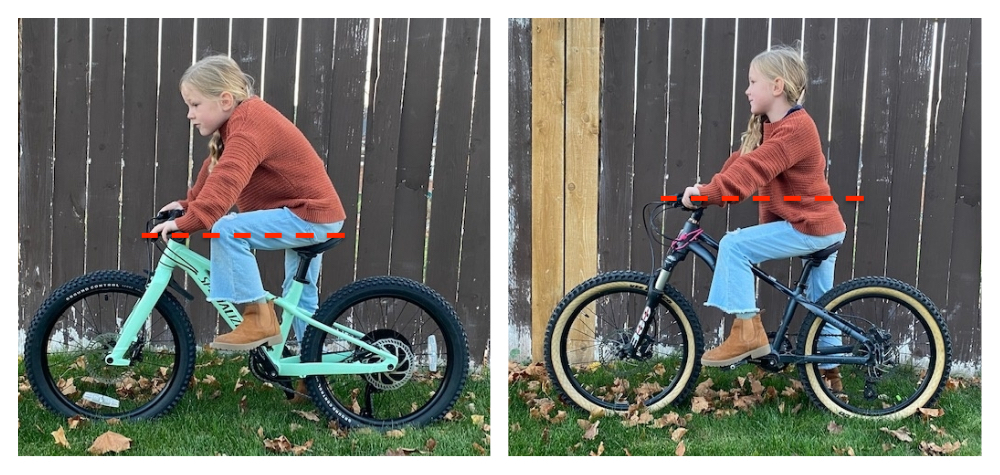
Moving up to the 24″, the low stack on the Riprock is also apparent when compared to the 24″ woom OFF AIR. The higher stack height and longer cockpit of the woom OFF AIR allow the rider’s hands to be positioned higher than on the Riprock.
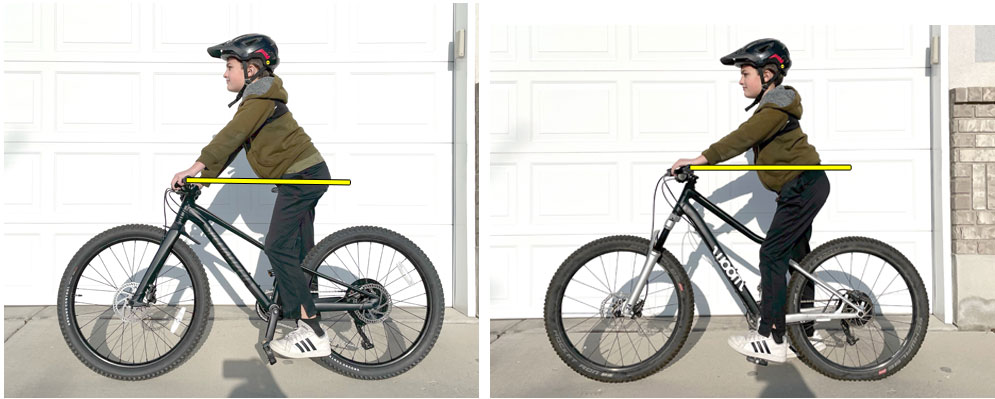
Being 54.5″ tall, our 9-year-old tester above is on the edge of Specialized’s recommended max height of 55″ for their 24″ Riprocks. Throughout our testing process, our 9-year-old tester loved the Riprock and had no complaints about the geometry of the bike, but unlike the woom OFF, for a child his height, the Riprock does not provide room for growth.
Riprock 24″ Expert Geometry
The Riprock Expert with a front suspension fork, however, is actually less aggressively positioned than the rigid Riprock. Although the suspension fork does help to raise the front end of the bike, the frame of the Expert is actually different and features a longer wheelbase as well as a higher stack.
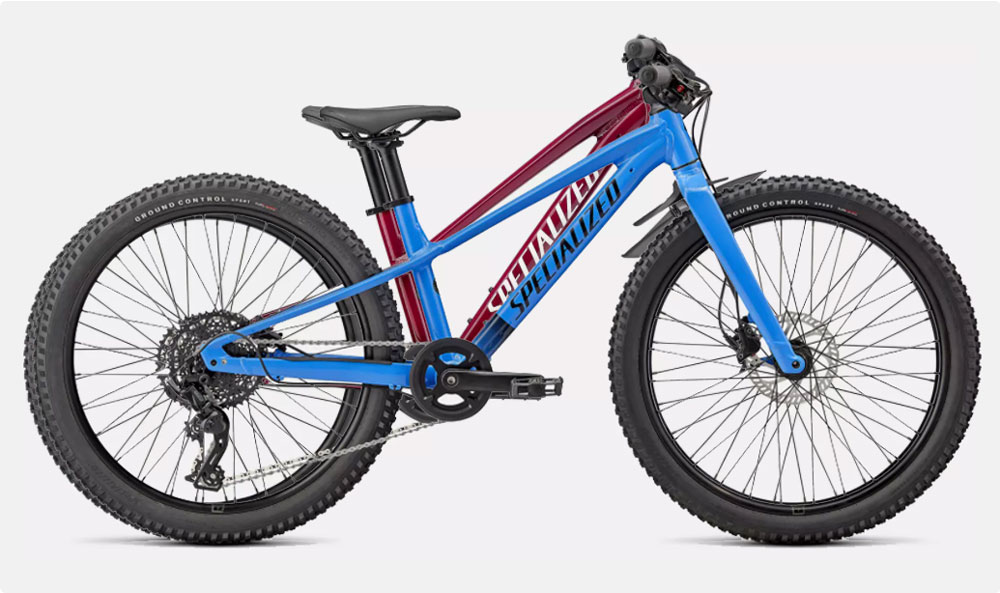
Specialized Riprock vs. Other Brands
The woom OFF, Prevelo Zulu, and Riprock are built for the same size rider but cater to different riding styles. The woom OFF’s less aggressive geometry and ultra-lightweight frame are best suited for timid riders just getting started on single-track. The longer wheelbase, slacker head tube angle, and included suspension fork of the Prevelo Zulu are ideal for more aggressive cross-country riders.
Meanwhile, the Riprock carves out its own place with the most aggressive positioning of the three, but also the most affordable! The Riprock is also dropper post compatible (yes, even the 20″), which truly goes to show that the Riprock is really designed for young rippers.
Specialized Riprock 20 Comparison

| Riprock 20 | woom OFF 4 | Prevelo Zulu 3 | |
| MSRP | $650 | $799 | $1,019 |
| Seat Height | 25″ – 30″ | 22.8″ – 28.7″ | 22.8″ – 28.5″ |
| Weight | 22.6 lb. | 17.2 lb. | 23 lb. |
| Head tube angle | 68° | 68° | 66° |
| Seat tube angle | 73.5° | 70° | 74° |
| Wheelbase | 830mm | 838mm | 892mm |
| Handlebar Width | 600mm | 580mm | 600mm |
| Handlebar Height (from ground) | 692mm | 770mm |
Specialized Riprock 24 Comparison

| Riprock 24 | woom OFF 5 | Prevelo Zulu 4 | |
| MSRP | $700 | $849 | $1,049 |
| Seat Height | 27″ – 32.5″ | 27.8″ – 33.6″ | 26″ – 31.5″ |
| Weight | 24.7 lb. | 18.9 lb. | 25.4 lb. |
| Head tube angle | 68° | 68° | 66° |
| Seat tube angle | 73.5° | 70° | 74° |
| Wheelbase | 953mm | 965mm | 1,002mm |
| Handlebar Width | 620mm | 600mm | 610mm |
| Handlebar Height (from ground) | 813mm | 874mm |
Specialized Riprock Base Model Components
From tires to shifters, we’ll cover all the major components on the base Riprock model. The upgraded components found on the Riprock Expert are outlined in the next section.
Hydraulic Disc Brakes
Both the 20 and the 24 Riprock come with hydraulic disc brakes with 160mm rotors on the front and rear. The small reach levers are easily adjustable and are quite responsive to young hands.
The base Riprock (non-suspension models) comes with C-STAR radius brakes (levers and calipers), a brand we are unfamiliar with, but our tester had no complaints in regards to reach or effort needed to engage to the brakes.

9-Speed Drivetrain, Trigger Shifters
The Microshift Advent trigger shifters on the Riprock 20 and 24 were easy to engage and our young tester had no problems putting them to work. With 9-speeds to work through, the Riprock offered plenty of gears whether pointed up or down the mountain.

The Microshift Advent derailleur features a clutch for a quieter ride and less chain bounce.

Wide Handlebar & Ergonomic Saddle
While the base level Riprock doesn’t have the suspension fork many MTB parents expect to see, it does comes standard with a wide handlebar for extra stability on the trail. The Riprock 20 comes with a 600mm bar while the 24 has a 620mm wide bar.
While the bar was too wide to comfortably fit our 9-year-old tester, the grips provided enough space for him to adapt by positioning his hands in closer.

To keep little bums happy, the Riprock saddle is narrower to fit smaller frames and has plenty of padding for the ride.

Wide 2.35″ Tires, But Not Tubeless Ready
With plenty of traction and squish, the Specialized’s Ground Control 2.35″ wide tires provide plenty of bite to keep wheels firmly planted on a wide variety of terrains. From softly packed hero dirt to loose gravel dusty patches, the tires on the Riprock did us well.
As a note, while the Riprock and the Riprock Expert both have Ground Control tires, the tires on the Expert are tubeless-ready, while the tires on the Riprock 20 and 24 are not.

Specialized Riprock 24 vs. Riprock Expert
Designed for the really aggressive grom, the Riprock Expert 24 is a whole different beast than the base model Riprock. For our single-track-loving testers who regularly ride everything from smooth green lines to chunky intermediate blue lines, the base model was more than adequate.
But what upgrades does the Riprock Expert offer? Although the Riprock and Riprock Expert have a similar frame design (the Expert has some tweaks due to the suspension fork), the Expert is more than double the price! While the large jump is mainly due to the Expert’s suspension fork, the drivetrain, brakes and tires are also upgraded.
| Riprock 24 | Riprock Expert 24 | |
| MSRP | $700 | $1,500 |
| Fork | Rigid alloy | Manitou JUNIT 24, 100mm travel, 1.5” tapered |
| Drivetrain | microSHIFT Advent, 9-speed | SRAM NX, 11-speed |
| Brakes | C-STAR Hydraulic Disc Brake, 160mm rotor | SRAM Level hydraulic disc, 160mm rotor |
| Tires | Ground Control Sport, 24×2.35″ | Tubeless Ready Ground Control, 24×2.35″ |
Specialized Riprock 20 and 24 Bottom Line
For young riders anxious to hit the hero dirt, the Specialized is a killer bike with an affordable price point. Offering a lightweight build with modern geometry, hydraulic disc brakes, and responsive trigger shifters, the Riprock is sure to quickly build your ambitious kid’s confidence and skill level. You’ll be taking them on longer and more technical trails in no time!
Related Articles
Best 24 Inch Kids Mountain Bikes – Our favorite picks for all types of riders ages 7 to 10 years old.
Best 20 Inch Kids Mountain Bikes – Our favorite bikes for riders ages 5 to 7 years old.
FTC Disclosure: Affiliate links are included in this review. No monetary compensation was provided for this review, however, the reviewed product was supplied by the manufacturer or distributor to help facilitate this review. All opinions and images are that of Two Wheeling Tots LLC. All content and images are copyrighted and should not be used or replicated in any way. View our Terms of Use.
